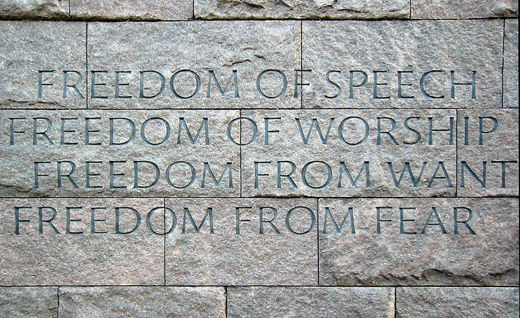
Seventy-five years ago, in his January 6, 1941, State of the Union address before Congress, U.S. President Franklin D. Roosevelt articulated the fundamental goals of Four Freedoms that people “everywhere in the world” ought to enjoy: Freedom of speech, Freedom of worship, Freedom from want, and Freedom from fear.
FDR’s speech was largely about national security and the threat to democracy from world war that was being waged in Europe and Asia. The Nazis had already occupied much of continental Europe. Roosevelt outlined the U.S. role in helping allies already engaged in warfare, 11 months before the U.S. declared war on Japan and the Axis powers.
The president listedsuch benefits of democracy as economic opportunity, employment, social security, and the promise of “adequate health care.” The first two freedoms, of speech and religion, are protected by the First Amendment in the U.S. Constitution. His inclusion of the latter two freedoms went beyond the traditional Constitutional values protected by the U.S. Bill of Rights. Roosevelt endorsed a broader human right to economic security and anticipated what would become known decades later as the “human security” paradigm in economic analysis.
FDR’s”freedom from fear””means a world-wide reduction of armaments to such a point and in such a thorough fashion that no nation will be in a position to commit an act of physical aggression against any neighbor – anywhere in the world. That is no vision of a distant millennium. It is a definite basis for a kind of world attainable in our own time and generation. That kind of world is the very antithesis of the so-called new order of tyranny which the dictators seek to create with the crash of a bomb.”
Clearly, as the year 1941 dawned, the U.S. was heading into the war. The country still suffered the memory of World War I, and many important sectors of public sentiment opposed intervention in what was seen as a new imperialist war that was none of our business. Pro-fascist elements in the U.S. were cheering on Nazi advances. The Communist Party also opposed intervention at this stage, for the USSR, the only socialist country in the world, was at that time at peace with Germanyand a premature expansion of the war would have imperiled the Soviet state.
The Four Freedoms Speech provided a rationale for why the U.S. should abandon its policies of isolationism. “No realistic American can expect from a dictator’s peace international generosity,” Roosevelt said, “or return of true independence, or world disarmament, or freedom of expression, or freedom of religion – or even good business. Such a peace would bring no security for us or for our neighbors…. Those who would give up essential liberty to purchase a little temporary safety, deserve neither liberty nor safety.”
The declaration of the Four Freedoms would resonate through the remainder of the war, and for decades longer. Through its establishment in the canon of great American ideas, as well as the famous paintings of Norman Rockwell, the Freedoms were advertised as values central to American life and examples for the world. FDR’s critics who opposed his New Deal programs and who saw no problem with millions of human beings “in want” and “in fear” seized on this speech as more evidence of his rampant leftism.
Despite the ringing idealism of the Four Freedoms speech, historical experience and practical politics militated against universal application of these principles in the U.S. any time soon. Racial minorities and women were still treated with fewer rights almost everywhere in America. Only a year later, on February 19, 1942, the president himself signed Executive Order 9066, which established a network of internment camps for Americans of Japanese ancestry.
The Four Freedoms became part of the personal mission undertaken by FDR’s widow Eleanor Roosevelt regarding her inspiration behind the 1948 United Nations Declaration of Human Rights, whose preamble specifically mentions them.
Like other aspirational documents throughout history, the Four Freedoms speech stands as a testament to the best and highest in human thought. It remains the work of later generations to fulfill its eloquent promise.
The Franklin D. Roosevelt Four Freedoms Park, designed by the architect Louis Kahn for the south point of Roosevelt Island in New York City, celebrates the famous speech. Text from the speech is inscribed on a granite wall in the final design.
Adapted from Wikipedia and other sources.
Photo: Wikipedia (CC)

MOST POPULAR TODAY

High Court essentially bans demonstrations, freedom of assembly in Deep South

U.S. imperialism’s ‘ironclad’ support for Israel increases fascist danger at home

Zionist organizations leading campaign to stop ceasefire resolutions in D.C. area


UN warns that Israel is still blocking humanitarian aid to Gaza






Comments